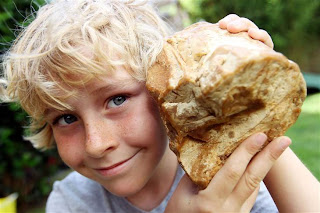 |
Daily Echo via BNPS.co.uk /
Eight-year-old Charlie Naysmith shows off the piece of ambergris he
found on the beach at Hengistbury Head on the coast of southern England.
|
The find is also known as ambergris--or floating gold--a product used in expensive French perfumes.
Here's how NBC Science News describes ambergris:
Ambergris is a waxy, bile-like substance that builds up in the intestines of sperm whales, apparently to ease the passage of hard material such as squid beaks through a whale's digestive tract. It's often characterized as whale vomit, and although that's fine as a family-friendly description, the stuff is more widely thought to come out of the whale's back end rather than its front end.
Fresh ambergris smells like fresh whale poop, but after a long period of seasoning and hardening in the ocean, it takes on a more delicate odor. It's been variously compared to the aroma of tobacco, the scent of an old wooden church, the fragrance of seaweed, or the smell of rubbing alcohol without the pungency.

